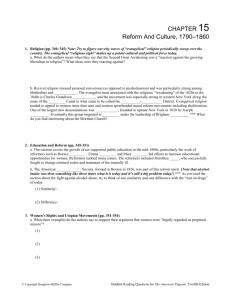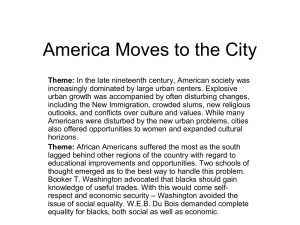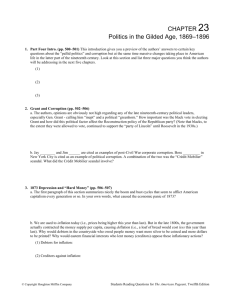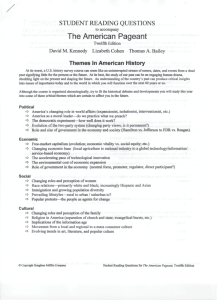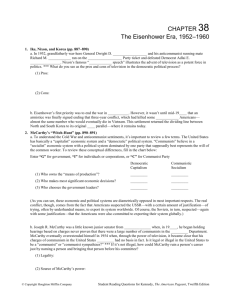Chapter 25
advertisement
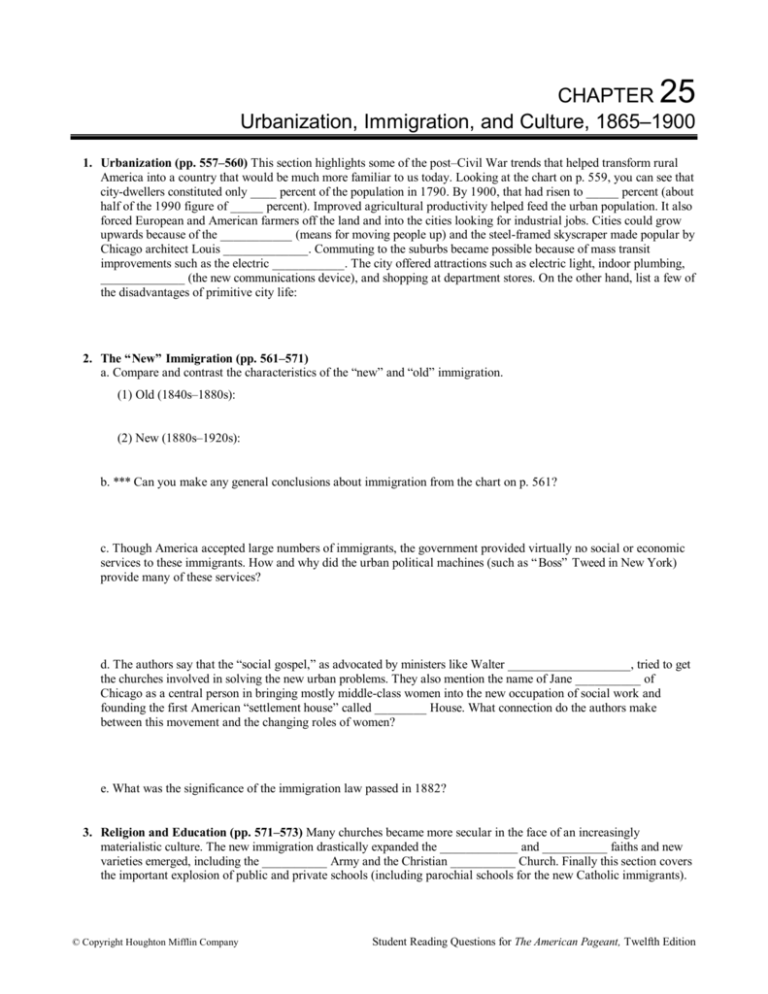
25 CHAPTER Urbanization, Immigration, and Culture, 1865–1900 1. Urbanization (pp. 557–560) This section highlights some of the post–Civil War trends that helped transform rural America into a country that would be much more familiar to us today. Looking at the chart on p. 559, you can see that city-dwellers constituted only ____ percent of the population in 1790. By 1900, that had risen to _____ percent (about half of the 1990 figure of _____ percent). Improved agricultural productivity helped feed the urban population. It also forced European and American farmers off the land and into the cities looking for industrial jobs. Cities could grow upwards because of the ___________ (means for moving people up) and the steel-framed skyscraper made popular by Chicago architect Louis _____________. Commuting to the suburbs became possible because of mass transit improvements such as the electric ___________. The city offered attractions such as electric light, indoor plumbing, _____________ (the new communications device), and shopping at department stores. On the other hand, list a few of the disadvantages of primitive city life: 2. The “New” Immigration (pp. 561–571) a. Compare and contrast the characteristics of the “new” and “old” immigration. (1) Old (1840s–1880s): (2) New (1880s–1920s): b. *** Can you make any general conclusions about immigration from the chart on p. 561? c. Though America accepted large numbers of immigrants, the government provided virtually no social or economic services to these immigrants. How and why did the urban political machines (such as “Boss” Tweed in New York) provide many of these services? d. The authors say that the “social gospel,” as advocated by ministers like Walter ___________________, tried to get the churches involved in solving the new urban problems. They also mention the name of Jane __________ of Chicago as a central person in bringing mostly middle-class women into the new occupation of social work and founding the first American “settlement house” called ________ House. What connection do the authors make between this movement and the changing roles of women? e. What was the significance of the immigration law passed in 1882? 3. Religion and Education (pp. 571–573) Many churches became more secular in the face of an increasingly materialistic culture. The new immigration drastically expanded the ____________ and __________ faiths and new varieties emerged, including the __________ Army and the Christian __________ Church. Finally this section covers the important explosion of public and private schools (including parochial schools for the new Catholic immigrants). © Copyright Houghton Mifflin Company Student Reading Questions for The American Pageant, Twelfth Edition 4. African-Americans react to “Jim Crow” (pp. 573–575) a. By 1900, the day-to-day plight of blacks was little better than it had been under slavery. Summarize the views of these two leaders on the subject of black advancement. *** Under conditions prevailing at the time, which of these would you have supported and why? (1) Booker T. Washington: (2) W. E. B. DuBois: (3) Your view: 5. Universities, Press, and Literature (pp. 575–581) Expansion of public universities was boosted by passage of the __________ Act of 1862 granting land for this purpose, and “robber barons” such as Leland __________ used their wealth to found many private universities. Andrew _________ funded the expansion of public libraries and the circulation of newspapers increased, notably with the competition between “yellow journalists” Joseph __________ and William Randolph __________. Of the extensive list of quality writers and authors discussed at the end of this section, pick three that you like and list a few of their characteristics. *** Have you read anything by any of them? (1) (2) (3) 6. Moral Values and Women’s Rights (pp. 581–585) a. The new urban environment sparked debate over changing sexual attitudes and the role of women in the family. A new generation of women activists formed the National American Women’s ____________ Association in 18___. What were the differing arguments of the following two leaders in favor of women’s suffrage? *** Then put a (W) by the leader whose argument seems to you to be most similar to that of Booker T. Washington, and a (D) by the one whose argument you can connect to that of W. E. B. DuBois. ____ 1. Charlotte Perkins Gilman: ____ 2. Carrie Chapman Catt: 7. Reform, Art, and Culture (pp. 585–589) Women, most notably the colorful Carrie A. ________, led the fight against excessive drinking (mostly by men!), forming the Woman’s ____________ ______________ Association in 1874. Artists of the period included James _________ and Winslow __________. Popular music blossomed, including uniquely American forms of blues, ragtime, and jazz. The biggest world’s fair ever, the Great __________ Exposition, was held in __________ in 1893. And urban Americans had the time and money for new popular amusements such as the circus and spectator sports such as baseball, football, and boxing. *** After reading this chapter, reflect a bit on life at the end of the nineteenth century. Imagine growing up in this period and list one or two advantages and disadvantages compared to today. (1) Advantages: (2) Disadvantages: © Copyright Houghton Mifflin Company Student Reading Questions for The American Pageant, Twelfth Edition CHAPTER 25 TERM SHEET Urbanization, Immigration, and Culture Pages 557–560 Louis Sullivan Theodore Dreiser (Sister Carrie, 1900) “Dumbbell” tenements Pages 561–571 “Padrone system” Boss Tweed Walter Rauschenbusch “Social Gospel” Jane Addams Hull House (1889) Lillian Wald Florence Kelley “Nativism” American Protective Association, 1887 Immigration restriction laws, 1882 and 1885 Pages 571–573 Dwight Lyman Moody Cardinal Gibbons Mary Baker Eddy “Normal” schools Kindergartens Chautauqua movement Pages 573–575 Booker T. Washington George Washington Carver W. E. B. DuBois NAACP (1910) © Copyright Houghton Mifflin Company Student Reading Questions for The American Pageant, Twelfth Edition Pages 575–581 Morrill Act (1862) Hatch Act (1867) Dr. Charles W. Eliot William James Carnegie libraries Joseph Pulitzer “Yellow journalism” William Randolph Hearst Edwin L. Godkin (The Nation, 1865) Henry George (Progress and Poverty, 1879) Edward Bellamy (Looking Backward, 1888) Gen. Lewis Wallace (Ben Hur, 1880) Horatio Alger Walt Whitman (Leaves of Grass) Emily Dickinson Kate Chopin (The Awakening, 1899) Mark Twain Bret Harte William Dean Howells Stephen Crane (Red Badge of Courage, 1895) Henry James Jack London Frank Norris Pages 581–585 Victoria Woodhull Anthony Comstock Charlotte Perkins Gilman National Women’s Suffrage Association, (NWSA, 1890) © Copyright Houghton Mifflin Company Student Reading Questions for The American Pageant, Twelfth Edition Carrie Chapman Catt Ida B. Wells National Association of Colored Women (1896) Pages 585–589 Women’s Christian Temperance Association (WCTA, 1874) Frances E. Willard Carrie Nation Anti-Saloon League (1893) Clara Barton James Whistler John Singer Sargent George Inness Thomas Eakins Winslow Homer Augustus Saint-Gaudens Henry H. Richardson Columbian Exposition (Chicago, 1893) Vaudeville Phineas T. Barnum/James A. Bailey “Buffalo Bill” Cody Sports (participation and spectator) “Gentleman Jim” Corbett James Naismith © Copyright Houghton Mifflin Company Student Reading Questions for The American Pageant, Twelfth Edition
